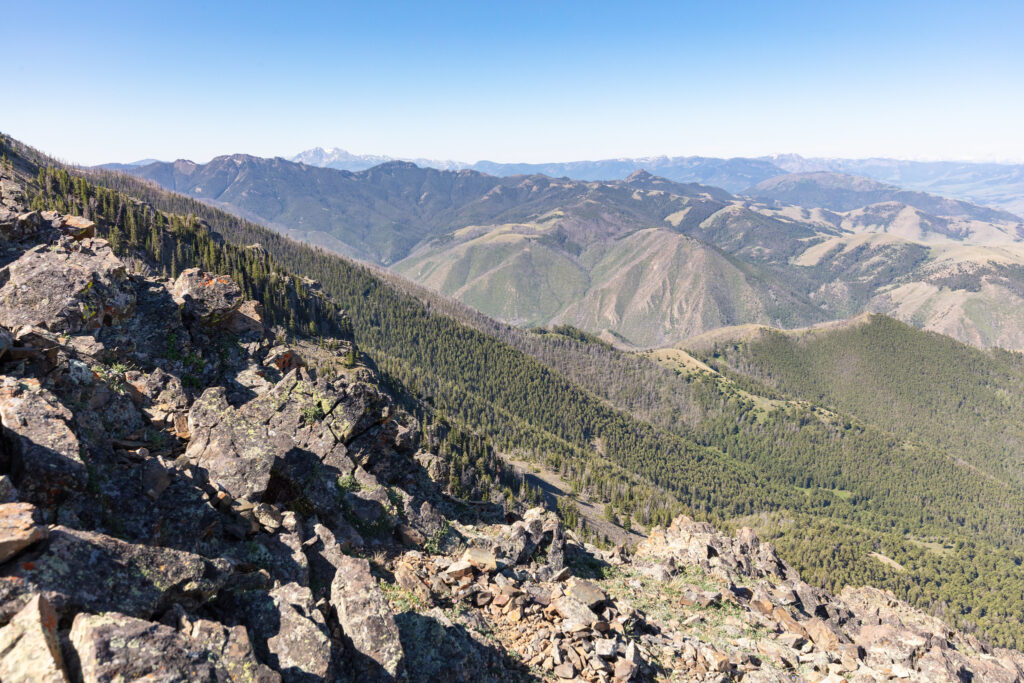The Custer-Gallatin National Forest, Emigrant Peak Trail: Gaining the ridge. (Photo by Jacob W. Frank of the National Park Service).
It is no secret that Southwest Montana is rapidly changing. With more people in local communities and on the trails, it is imperative we work together to protect and steward our cherished public lands. The Greater Yellowstone Coalition has been at the forefront of taking action to protect this special place for more than 40 years, successfully adapting strategies to present-day social, political, and ecological realities. GYC brings together diverse interests, organizes communities, and ultimately develops widely supported projects that protect the region’s remarkable lands, waters, and wildlife.
Recently, the coalition used this approach to pass two bills in Congress – the East Rosebud Wild and Scenic River Act that protects its namesake creek from dams and other development, and the Yellowstone Gateway Protection Act, which permanently protects lands in the Paradise Valley and along Yellowstone’s northern border from mining. This model works, not just here in Greater Yellowstone but across the West where it has been the basis for legislation protecting hundreds of thousands of acres over the past two decades.
For almost 10 years, GYC and many conservation groups, local businesses, and outdoor enthusiasts organized hundreds of meetings to learn about and discuss the future of the Gallatin and Madison ranges. These grassroots conversations led to the Gallatin Forest Partnership Agreement, a community developed, locally tailored proposal for permanently protecting this remarkable landscape, that today has the support and endorsement of nearly 2,000 Montana residents, 125 businesses and organizations, two county commissions and a dozen local elected representatives.
The Gallatin Forest Partnership is made up of people from Big Sky, Bozeman, Livingston and points in between. These people worked tirelessly to review scientific reports, consider past and present forest management, engage various user groups, and map out the wide variety of activities and interests tied to these public lands. Most importantly, they worked through the hard discussions necessary to forge an agreement, and now draft legislation, that will protect Southwest Montana’s public lands and ensure future generations can enjoy them as much as we do.
The Greater Yellowstone Conservation and Recreation Act is so much bigger than any one group or person. It has to be. The conservation tent must be bigger, more inclusive, and open to innovative solutions in this era of rapid change. This proposal is our best chance to secure permanent protection for lands we love because it is the only proposal with a viable political strategy. It is from the community and for the community.
The Greater Yellowstone Conservation and Recreation Act will protect important habitat for iconic wildlife like grizzly bears, elk, wild trout and more. The bill will designate 124,000 acres of new wilderness in the Gallatin and Madison ranges. Plus, 31,000 acres at the southern end of the Gallatin Range and 25,000 acres in the northeast corner will be designated as Wildlife and Recreation Management Areas. This will protect important wildlife habitat by prohibiting new trails and areas from being opened to motorized recreation, while certain recreational uses that predate the Wilderness Study Area will still be permitted. Finally, 70,000 acres in Hyalite Canyon and the Bozeman Creek and South Cottonwood drainages will be preserved as a watershed protection and recreation area. This will ensure clean drinking water and protect beloved community trails.
All told, the Greater Yellowstone Conservation and Recreation Act will protect 250,000 acres and do what generations of conservationists have not been able to accomplish – pass legislation to permanently protect the wildlife, cold creeks, spectacular scenery, and outdoor recreation opportunities that are next-door to one of the fastest-growing regions in the United States.
This proposal is aligned with GYC’s mission, and we are proud of the staff and many organizations and individuals who have rolled up their sleeves and done the hard work of building a realistic and balanced plan. As this area continues to grow and more pressure is placed on Montana’s public lands, it will only become more difficult to reach consensus. In a time when passing bills in Congress is nearly impossible, inaction or holding out for an unattainable ideal means we all lose. Inaction is the greatest threat to conserving this special place. Thank you, GYC, and the long list of partners for working together to create this community-based conservation solution.
This commentary was written by Nancy Watters, Chairwoman and Rick Johnson, Vice Chairman, and submitted this on behalf of Greater Yellowstone Coalition’s Board of Directors.

